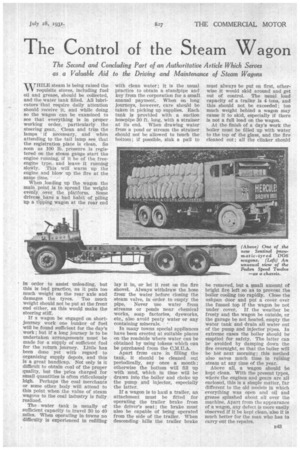The Control of the Steam Wagon
Page 61

If you've noticed an error in this article please click here to report it so we can fix it.
The Second and Concluding Part of an Authoritative Article Which Serves as a Valuable Aid to the Driving and Maintenance of Stearn Wagons
WHILE steam is being raised the requisite stores, including fuel oil and grease, should be collected, and the water tank filled. All lubricators that require daily attention should receive it, and while doing so the wagon can be examined to see that everything is in proper working order, particularly the steering gear. Clean and trim the lamps 'if necessary, and when attending to the tail lamp see that the registration plate is clean. So soon as 100 lb. pressure is registered on the steam gauge start the engine running, if it be of the freeengine type, and leave it running , slowly. This will warm up the engine and blow up the fire at the same time.
When loading up the wagon the main point is to spread the weight evenly, ,oyer the platform. Some drivens have a bad, habit of piling up a tipping wagon at the rear end
, in order to assist unloading, but this is bad practice, as it nuts too much weight on the rear axle and damages the tyres. Too much weight should not be put at the front end either, as this would make the steering stiff.
If a wagon be engaged on shortjourney work one bunker of fuel will he found sufficient for the day's work ; but if a long journey is to be undertaken arrangements must be made for a supply of sufficient fuel for the return journey. Little has been done yet with regard to organizing supply depots, and this is a great handicap. Not only is it difficult to obtain coal of the proper quality, but the price charged for stuall quantities is often ridiculously high. Perhaps the coal merchants or some other body will attend to this point when the value of steam wagons to the coal industry is fully realized.
The water tank is usually of sufficient capacity to travel 30 to 40 miles. When operating in towns no difficulty is experienced in refilling
with clean water ; it is the usual practice to obtain a standpipe and key from the corporation for a small annual payment. When on long journeys, however, care should be taken in picking up supplies. Each tank is provided with a suction hosepipe 30 ft. long, with a strainer at its end. When drawing water from a pond or stream the strainer should not be allowed to touch the bottom ; if possible, sink a pail to
lay it in, or let it rest on the fire shovel. Always withdraw the hose from the water before closing the steam valve, in order to empty the pipe, Never use water from streams or ponds near chemical works, soap factories, dyeworks, etc., also avoid peaty water or any containing minerals.
In many towns special appliances have been erected at suitable places on the roadside where water can be obtained by using tokens which can be purchased from the C.M.B.A.
Apart from care in filling the tank,it should be cleaned out periodically, say once a month ; otherwise the bottom will fill up with mud, which in time will be drawn into the boiler and choke up the pump and injector, especially the latter.
If a wagon is to haul a trailer, an attachment must be fitted for operating the trailer brake from the driver's seat ; the brake must also be capable of being operated from the side of the trailer. When descending hills the trailer brake must always be put on first, otherwise it would skid around and get out of control. The usual load capacity of a trailer is 4 tons, and this should not be exceeded ; too much weight behind a wagon may cause it to skid, especially if there Is not a full load on the wagon.
At the finish of a day's work the boiler must be filled up with water to the top of the glass, and the fire cleaned out; all the clinker should be removed, but a small amount of bright fire left so as to prevent the boiler cooling too rapidly. Close the ashpan door and put a cover over the funnel top if the wagon be not under cover. If the weather be frosty and the wagon be outside, or the garage be not heated, empty the water tank and drain all water out of the pump and injector pipes. In extreme eases the boiler should be emptied for . safety. The latter can be avoided by damping down the fire overnight, so that the boiler will be hot next morning; this method also saves much time in raising steam at any time of the year.
Above all, a wagon should be kept clean. With the present types, where the engines and gears are all enclosed, this is a simple matter, far different to the old models in which everything was open and oil and grease splashed about all over the machine. Apart from the appearance of a wagon, any defect is more easily observed if it be kept clean, also it is much better for the man who has to carry out the repairs.




































































































